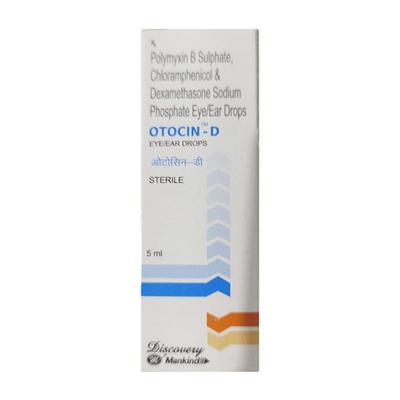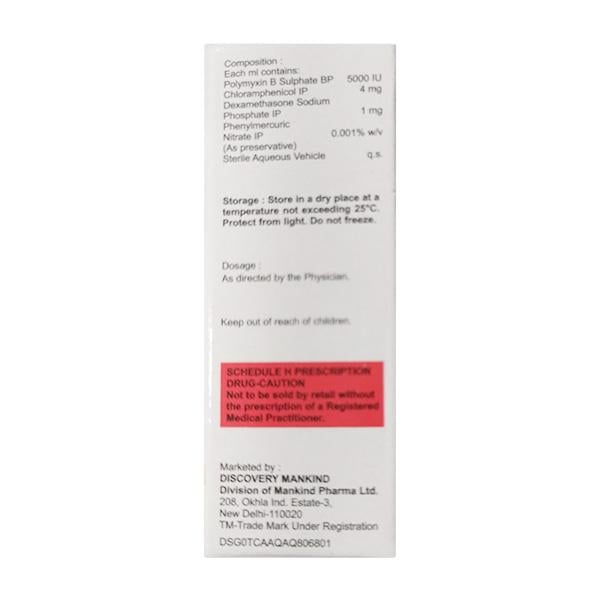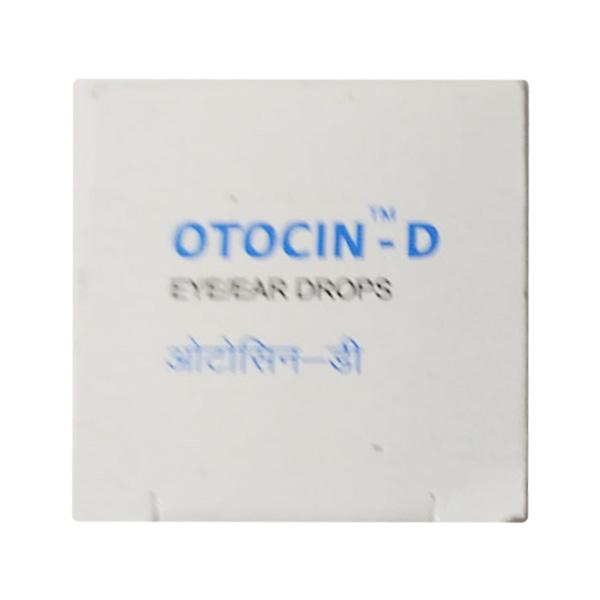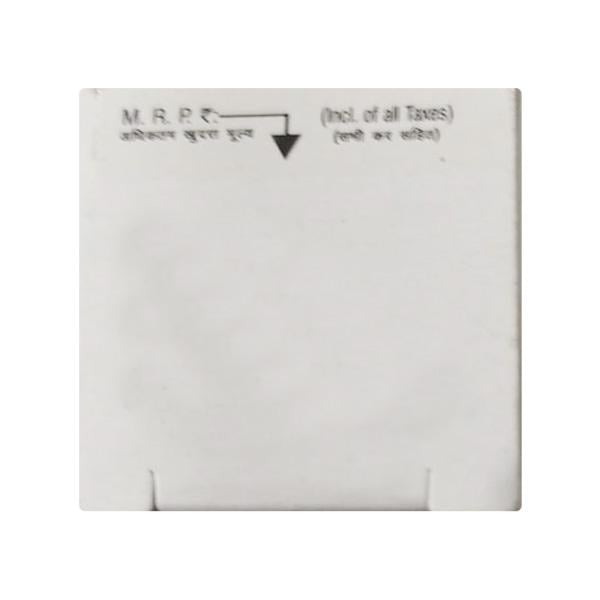

Netmeds First Membership
Quick Links
Introduction About OTOCIN D EYE/EAR DROPS
OTOCIN D EYE/EAR DROPS is a combination of Chloramphenicol and Polymyxin B which belongs to the group of medicines called Antibiotics and Corticosteroids respectively. It is used in adults to manage bacterial infections of the eyes and ear canal. Eye infection is characterized by warmth, redness, swelling and pain. Ear infection can show symptoms like ear pain, fever, irritability, rubbing or tugging ear or difficulty sleeping.
During course of the management your doctor might regularly examine your eye and ear to avoid any untoward side effects. The safety and effectiveness of OTOCIN D EYE/EAR DROPS have not been established in children.
Before using OTOCIN D EYE/EAR DROPS, inform your doctor if you have an injury or ulcer of the cornea, fungal or viral (herpes simplex) eye infections, severe blood disorders, liver problems or family history of impaired bone marrow function. OTOCIN D EYE/EAR DROPS is not recommended in pregnant or breastfeeding women.
The most common side effects of using OTOCIN D EYE/EAR DROPS are temporary burning, stinging, irritation, itching and redness. Consult your doctor if any of the side effects worsen.
Uses Of OTOCIN D EYE/EAR DROPS
- Manage bacterial infections of the eyes and ear canal
How OTOCIN D EYE/EAR DROPS Works
OTOCIN D EYE/EAR DROPS manages infection, where chloramphenicol inhibits bacterial protein synthesis by binding to the 50S ribosomal subunit and directly managing the formation of bacterial protein, dexamethasone suppresses the migration and decreases the multiplication of certain cells that are responsible for inflammation, along with making the membrane less permeable and polymyxin B interacts with certain molecules of the outer membrane of infecting bacteria, changing membrane permeability and killing the cell.
How to use OTOCIN D EYE/EAR DROPS
Use OTOCIN D EYE/EAR DROPS as advised by your doctor. It is for external use only. Do not touch the tip of the dropper on any surface. Squeeze the dropper gently, then dispense the medication inside the lower eyelid or ear. Your doctor will decide the correct dose and duration for you depending upon your age, disease condition and body weight.
Side Effects Of OTOCIN D EYE/EAR DROPS
Common
- temporary burning, stinging, irritation, itching, redness
Stop using OTOCIN D EYE/EAR DROPS and consult your doctor immediately if you experience any of the following side effects:
- blurry eyesight or other visual disturbances
- cushing's syndrome or adrenal suppression
How To Manage Side Effects
Eye irritation Or Itching
Wash your eyes with plain cold water. Place an ice pack on your eye to soothe the irritation. Avoid straining your eyes by keeping away from mobile phones, laptops or television. Wear protective sunglasses while going outdoors. Consult your doctor if the symptom does not improve.
Warning & Precautions
Pregnancy
ContraindicatedOTOCIN D EYE/EAR DROPS is not recommended for use in pregnant women. Consult your doctor before using it.
Breastfeeding
ContraindicatedOTOCIN D EYE/EAR DROPS is not recommended for use in breastfeeding women. Consult your doctor before using it.
Driving and Using Machines
Use with CautionDo not drive or operate machinery if you are not sure if you have complete mental and physical alertness after using OTOCIN D EYE/EAR DROPS.
Kidney
Use with CautionOTOCIN D EYE/EAR DROPS should be used with caution in patients with kidney failure. Consult your doctor before using it.
Liver
Use with CautionOTOCIN D EYE/EAR DROPS should be used with caution in patients with liver impairment. Consult your doctor before using it.
Allergy
ContraindicatedDo not use OTOCIN D EYE/EAR DROPS if you are allergic to Chloramphenicol, Dexamethasone, Polymyxin B or any other ingredients of this medicine.
Use In Pediatrics
Consult your doctorThe safety and effectiveness of OTOCIN D EYE/EAR DROPS have not been established in children. Consult your doctor before using it.
Use In Geriatrics
Consult your doctorThe safety and effectiveness of OTOCIN D EYE/EAR DROPS have not been established in elderly patients. Consult your doctor before using it.
Others
OTOCIN D EYE/EAR DROPS is not recommended for use if you:
- had experienced bone marrow suppression during previous exposure to chloramphenicol
- have known personal or family history of blood dyscrasias including aplastic anaemia
- have fungal eye infection
- inflammation of front layer of due to herpes simplex virus
- infection of parts of eye like vaccinia, varicella and other viral infection
Before using OTOCIN D EYE/EAR DROPS, inform your doctor if you:
- have diseases that cause corneal thinning
- have severe bacterial conjunctivitis or an infection which is not confined to the conjunctivae
- wear contact lenses
- have diabetes (high blood sugar)
- you have any fungal infection
Interactions
A. Drug-Drug interactions:
Before using OTOCIN D EYE/EAR DROPS, inform your doctor if you are using any of the following medicines:
- atropine and related compounds (used to manage slow heartbeat)
- medicines used to manage fits (Ex. phenytoin, phenobarbitone)
- ephedrine (used to manage breathing problems)
- rifampicin (used to manage bacterial infections)
- neomycin (used to manage eye infections)
- medicines used to manage HIV infection (Ex. ritonavir, cobicistat)
- medicines used on skin to reduce pain (Ex. diclofenac, ibuprofen)
- medicines used on skin to reduce inflammation (Ex. hydrocortisone, mometasone)
Overdosage:
If you or anyone else accidentally used too much of OTOCIN D EYE/EAR DROPS, consult your doctor immediately or visit the nearby hospital.
Synopsis
| Drug | : | Chloramphenicol, Polymyxin B, Dexamethasone |
| Pharmacological Category | : | Antibiotics, Corticosteroid |
| Therapeutic Indication | : | Bacterial infection of eye or ear canal |
| Dosage Forms | : | Eye/Ear drops, Eye/Ear ointment |
More Information
Storage
- Keep OTOCIN D EYE/EAR DROPS out of reach of children
- Store in a cool place
FAQs About OTOCIN D EYE/EAR DROPS
Q: Can OTOCIN D EYE/EAR DROPS be used for fungal infections?
A: No, OTOCIN D EYE/EAR DROPS is used in patients with bacterial infections. Do not use this medicine for any other indication than prescribed for. Consult your doctor before using it for other purposes.
Q: Can I wear contact lenses while using OTOCIN D EYE/EAR DROPS?
A: No, all types of contact lenses should be avoided when you are being managed for eye infections. Call you doctor for further queries regarding OTOCIN D EYE/EAR DROPS use.
Q: Can I stop using OTOCIN D EYE/EAR DROPS on my own?
A: Do not stop using OTOCIN D EYE/EAR DROPS unless your doctor advises you to do so. You might need to discontinue using it in case any new infections or serious side effects occur. Call you doctor for further queries regarding OTOCIN D EYE/EAR DROPS use.
Q: Can OTOCIN D EYE/EAR DROPS be used in children?
A: The safety and effectiveness of OTOCIN D EYE/EAR DROPS is not established in children. Your child’s doctor will select a suitable alternative management for your child to manage the infection.
Q: What if I forget to use a dose of OTOCIN D EYE/EAR DROPS?
A: If you forget to use a dose of OTOCIN D EYE/EAR DROPS, use it as soon as you remember. However, omit the missed dose if it is almost time for the next one. Do not use the medicine two times to make up for a forgotten dose.
Q: What precautions do I need to follow while taking OTOCIN D EYE/EAR DROPS?
A: Patients using OTOCIN D EYE/EAR DROPS must inform their doctor about their pre-existing disease conditions like injury or ulcer of the cornea, fungal or viral (herpes simplex) eye infections, severe blood disorders, liver problems or family history of impaired bone marrow function. Patients should also inform if they are pregnant, breast-feeding or having any allergies. Contact your doctor immediately if you have any unusual symptoms.
Q: Can OTOCIN D EYE/EAR DROPS be used during pregnancy?
A: OTOCIN D EYE/EAR DROPS is not recommended for use during pregnancy as the safety of one of its ingredients in pregnancy has not been established and it may be absorbed in blood and cross the placenta. If you are pregnant, think you may be pregnant or planning to get pregnant, consult your doctor before using this medicine. Inform your doctor immediately if you become pregnant during management with OTOCIN D EYE/EAR DROPS.
References
1. KD. Tripathi. Corticosteroids. Tetracyclines and Chloramphenicol. Essentials of Medical Pharmacology. Seventh edition. 2013. Page-289, 739
2. Ginny C. Oong; Prasanna Tadi. Chloramphenicol. NIH National Library of Medicine, National center for biotechnology information. July 2022. [Accessed on 10th June 2022] https://www.ncbi.nlm.nih.gov/books/NBK555966/#article-19435.s3
3. Donavon B. Johnson; Michael J. Lopez; Brendan Kelley. Dexamethasone. NIH National Library of Medicine, National center for biotechnology information. May 2022. [Accessed on 10th June 2022] https://www.ncbi.nlm.nih.gov/books/NBK482130/#:~:text=Dexamethasone%20is%20a%20potent%20glucocorticoid,becomes%20less%20permeable%2C%20as%20well.
4. Centaur Pharmaceuticals Pvt. Ltd. and DCI Pharmaceuticals. Ocupol Dx (Chloramphenicol + Dexamethasone + Polymyxin B). [Revised in January 2022] [Accessed on 23rd June 2022] https://www.centaurpharma.com/downloads/2022/ophthalmology/anti-infectives/Ocupol%20DX%20Eye%20Drops%20Ointment.pdf
5. Pharmtak Ophthalmics (I) Pvt. Ltd. Takchlor-DX (Eye/Ear Drops) (Chloramphenicol + Dexamethasone + Polymyxin B) [Accessed on 23rd June 2022] https://www.pharmtakindia.com/product/takchlor-dx-eye-ear-drops/
Useful Diagnostic Tests
- Tympanometry














